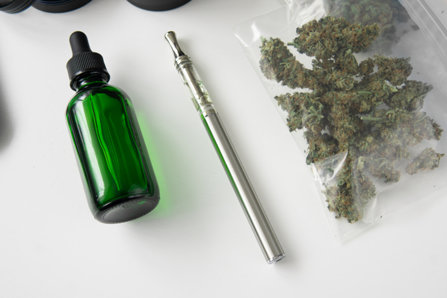Unregulated Substances are Often not What They Appear to Be – Part #2

Very recently, national news headlines flared with “vaping deaths.” The media, as it so often does, spun the exciting and dramatic aspects of the vape-related deaths into a story that would grab the most attention possible. The very first headlines read along the lines of, “People are dying from electronic cigarettes.” As it turned out, most of the vape-related death was caused by unregulated, bought-off-the-street vape juices that contained THC.
Vaping is already harmful, by itself. But adding THC and other, unregulated chemicals into home-made vape juices greatly increases the danger in vaping.
There is a risk and potential harm in buying vape products from the store. However, that risk is exponentially increased when one adds THC or other, unregulated substances to their vaporizer. Case in point, most of the recent deaths came about from adverse reactions to home-made, bought-off-the-street vape juice, e-liquids that had been imbued with THC and other, unknown chemical agents.
This story is yet another reason why we need to realize that unregulated substances are often not what they appear to be.
The Vape Story
In the state of New York, medical marijuana is legal. However, the unregulated vape juices in question contained additives, (such as vitamin E acetate), which were not approved additives for medicinal marijuana products.
The New York State Department of Health released a critical bulletin on this issue in September, shedding light on the recent vaping deaths in that state. According to the report, “Laboratory test results showed very high levels of vitamin E acetate in nearly all cannabis-containing samples analyzed. At least one vitamin E acetate-containing vape product has been linked to each patient who submitted a product for testing. Vitamin E acetate is not an approved additive for New York State Medical Marijuana Program-authorized vape products and was not seen in the nicotine-based products that were tested.” This doesn’t give the green light to nicotine-based products, it just means it takes longer for people to die from them.
The bulletin goes on to say that, “Vitamin E acetate is now a key focus of the Department’s investigation of potential causes of vaping-associated pulmonary illnesses. Vitamin E acetate is a commonly available nutritional supplement that is not known to cause harm when ingested as a vitamin supplement or applied to the skin. However, the Department continues to investigate its health effects when inhaled because its oil-like properties could be associated with the observed symptoms.”
The department warns New Yorkers to avoid “off the street” vape products. The bulletin insists that cannabis-enhanced vape liquids are not legal in New York. The unregulated products are not tested and may contain harmful substances, as the evidence clearly indicates.
The FDA Weighs In
After the issue in New York State became public, the Food and Drug Administration weighed in and offered its own cautionary statements. The media hubbub had already come and gone. There was plenty of evidence of the link between unregulated vape juice and vaping-related deaths by the time the FDA made a public statement.
“A majority of the samples tested by the states or by the FDA related to this investigation have been identified as vaping products containing THC. Through this investigation, we have also found most of the patients impacted by these illnesses reported using THC-containing products, suggesting THC vaping products play a role in the outbreak.”

Quoting the FDA, “A majority of the samples tested by the states or by the FDA related to this investigation have been identified as vaping products containing THC. Through this investigation, we have also found most of the patients impacted by these illnesses reported using THC-containing products, suggesting THC vaping products play a role in the outbreak.”
The FDA’s statement essentially mirrors the New York State Department of Health’s warning bulletin. Most of the recent vape-related deaths came from individuals who had gotten their vape juice from an unregulated supplier. All vaping has risk and is unhealthy, but the big concern here is unregulated, street-purchased vape products that contain THC and other illegal, unapproved additives.
The use of electronic cigarettes, mod vaporizers, or other methods of nicotine consumption is never “good” or “okay.” There’s certainly a great deal of cautionary evidence that all forms of nicotine consumption, whether it’s via cigarettes, pipes, chewing tobacco, vaporizers, vape pens, etc. have negative health implications. All of these habits and activities should be avoided. There is virtually unlimited data on this. But just for a quick glance, ABC News reported on the “epidemic" of teen vaping, and the CDC reported on the mind-boggling harms of cigarette use.
The purpose of this text was not to vindicate vaping. Instead, the point here was to show that using unregulated substances is even more dangerous than using regulated substances (which can also be harmful, depending on the material used).
Creating a Drug and Addiction-Free Society
It’s concerning that people are finding newer and newer ways of using cannabis-based drugs. It’s concerning that the vape industry has boomed and that vaping is so popular amongst young people (even if others have found a way to cease smoking cigarettes thanks to vaping).
Rather than getting stirred up over media headlines that demonize vaping and create further divide, we should be figuring out how to promote a totally substance-free life. People who use e-cigarettes in order to quit smoking tobacco might be interested in learning how to stop using e-cigarettes as well.
But figuring out how to put liquid cannabis extracts in e-liquid is a move in the wrong direction. We should be innovating safer and safer methods for quitting smoking, not figuring out ways to make vaping even more habit-forming. We should be working towards a society that has fewer addictive substances in it, not more.
Read Part #1
Sources:
- https://www.health.ny.gov/press/releases/2019/2019-09-05_vaping.htm
- https://www.fda.gov/consumers/consumer-updates/vaping-illness-update-fda-warns-public-stop-using-tetrahydrocannabinol-thc-containing-vaping
- https://abcnews.go.com/Politics/surgeon-general-warns-cigarettes-vaping/story?id=59873481
- https://www.cdc.gov/tobacco/data_statistics/sgr/2000/highlights/labels/index.htm
Reviewed by Claire Pinelli, ICAADC, CCS, LADC, MCAP, RAS


